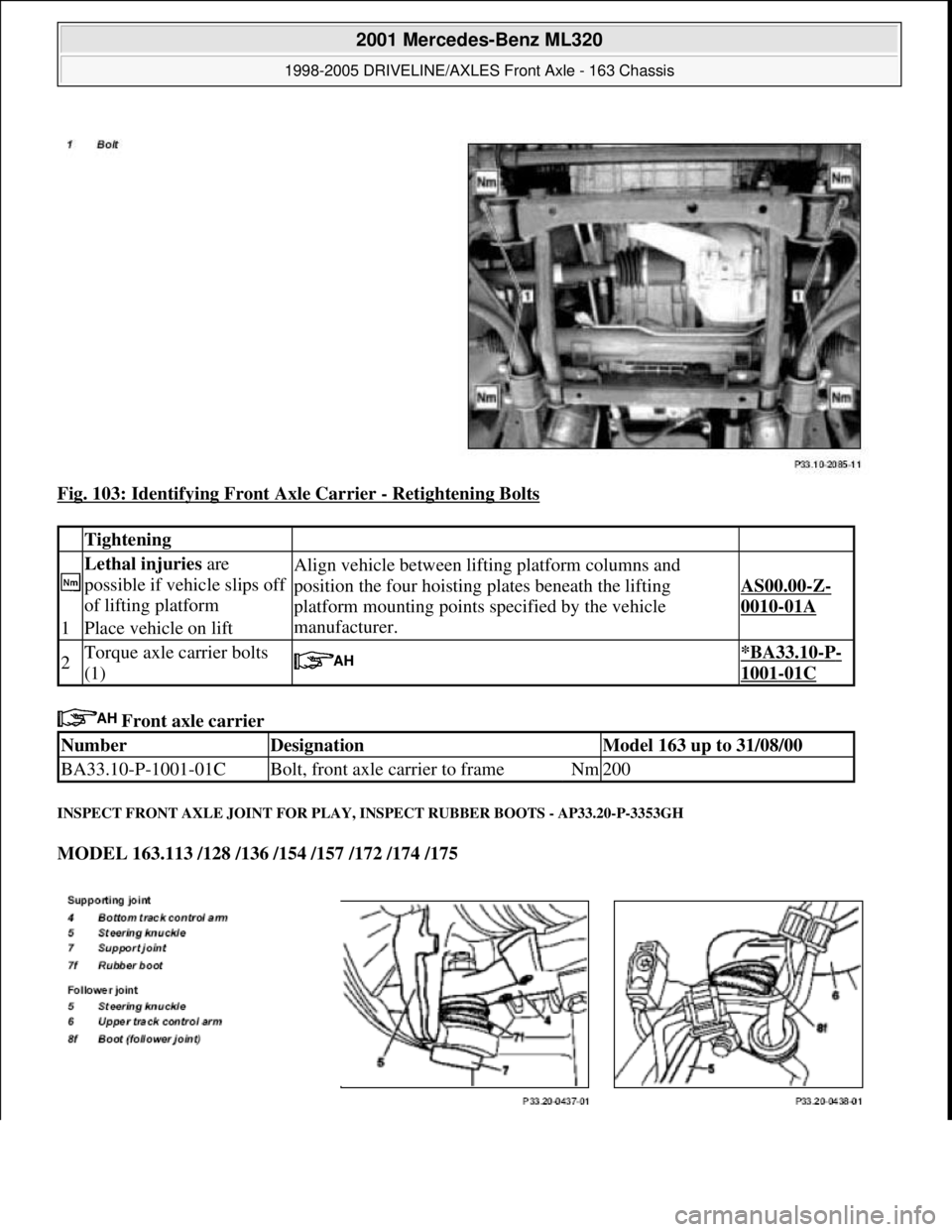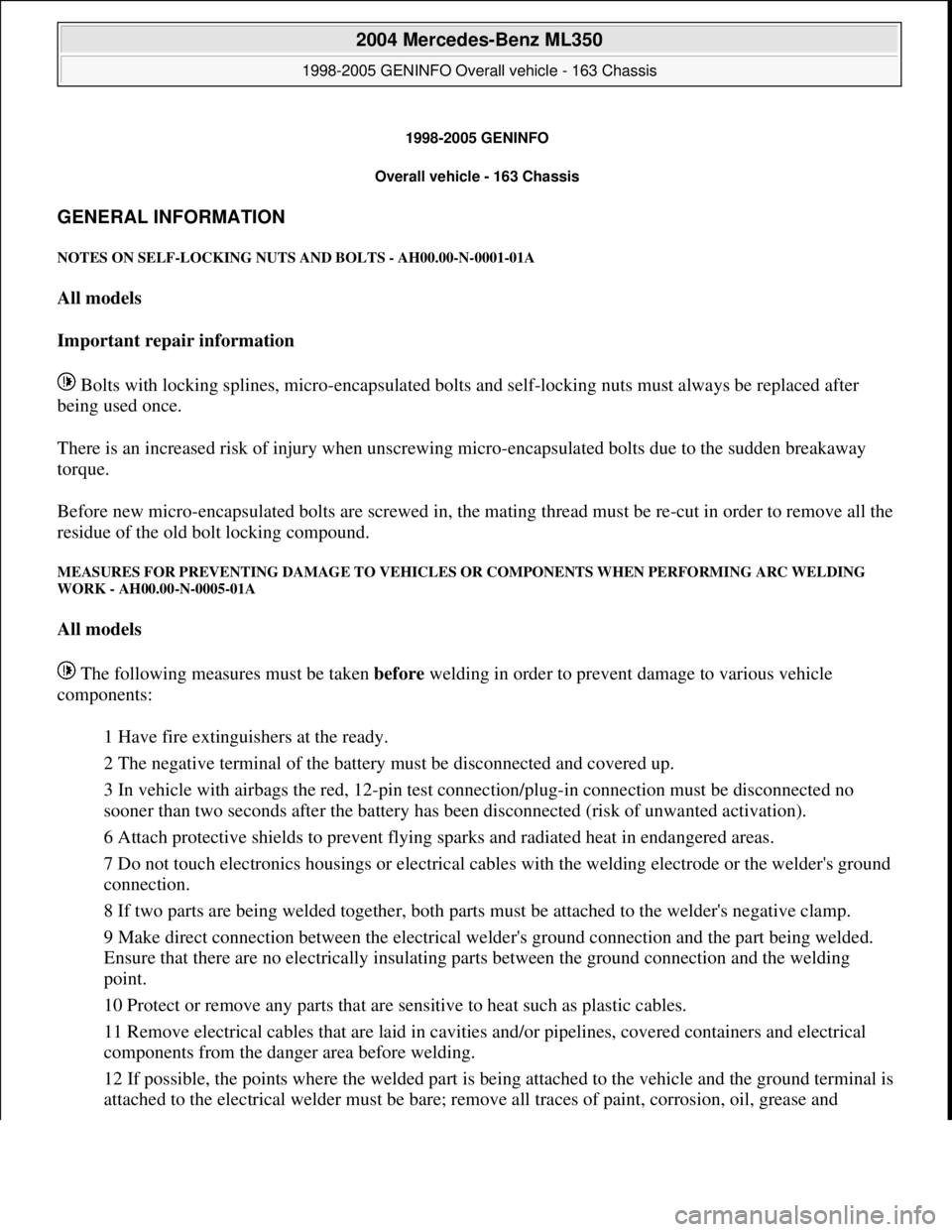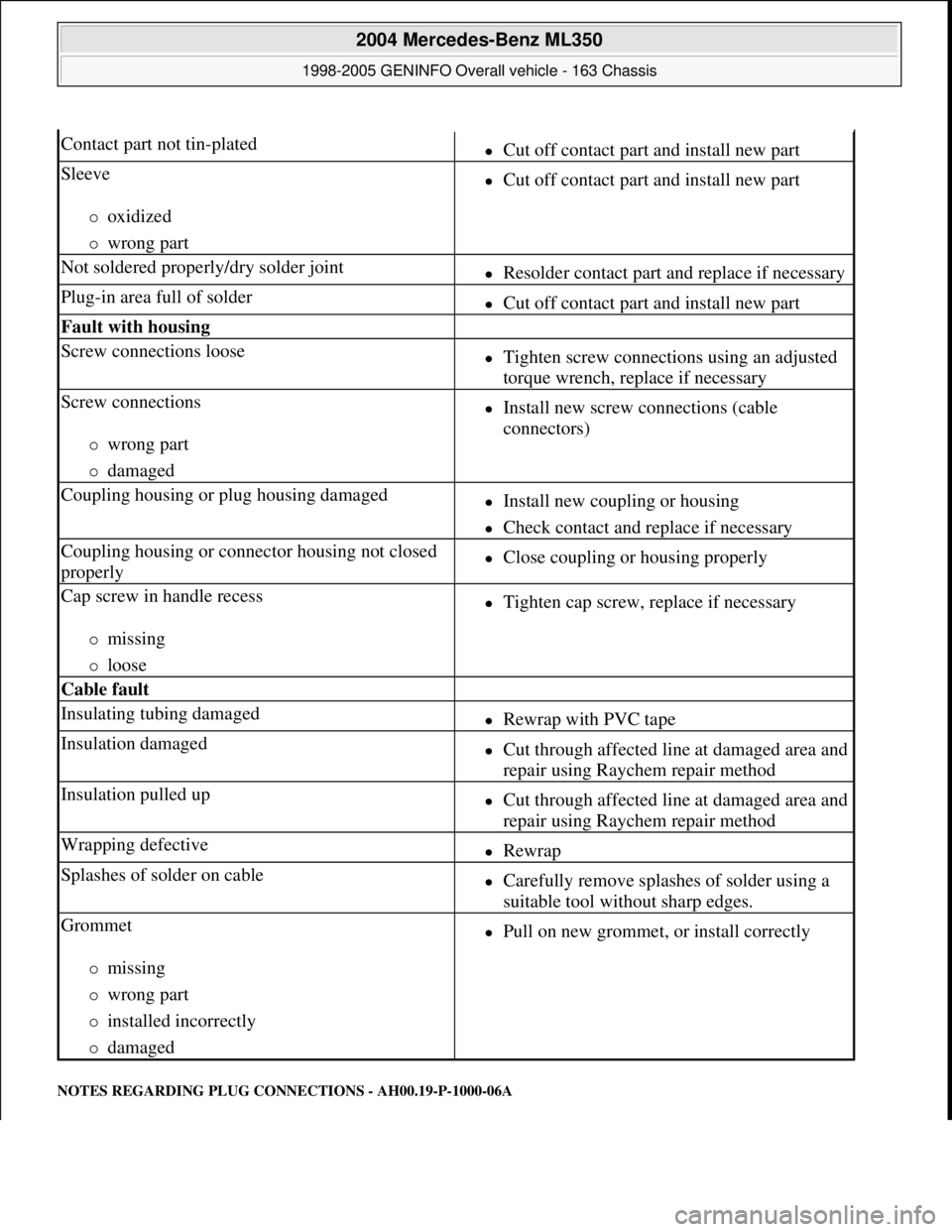1997 MERCEDES-BENZ ML430 torque
[x] Cancel search: torquePage 2579 of 4133

Fig. 103: Identifying Front Axle Carrier - Retightening Bolts
Front axle carrier
INSPECT FRONT AXLE JOINT FOR PLAY, INSPECT RUBBER BOOTS - AP33.20-P-3353GH
MODEL 163.113 /128 /136 /154 /157 /172 /174 /175
Tightening
Lethal injuries are
possible if vehicle slips off
of lifting platformAlign vehicle between lifting platform columns and
position the four hoisting plates beneath the lifting
platform mounting points specified by the vehicle
manufacturer.
AS00.00-Z-
0010-01A
1Place vehicle on lift
2Torque axle carrier bolts
(1) *BA33.10-P-
1001-01C
NumberDesignationModel 163 up to 31/08/00
BA33.10-P-1001-01CBolt, front axle carrier to frameNm200
2001 Mercedes-Benz ML320
1998-2005 DRIVELINE/AXLES Front Axle - 163 Chassis
me
Saturday, October 02, 2010 3:38:22 PMPage 60 © 2006 Mitchell Repair Information Company, LLC.
Page 2646 of 4133

1998-2005 GENINFO
Overall vehicle - 163 Chassis
GENERAL INFORMATION
NOTES ON SELF-LOCKING NUTS AND BOLTS - AH00.00-N-0001-01A
All models
Important repair information
Bolts with locking splines, micro-encapsulated bolts and self-locking nuts must always be replaced after
being used once.
There is an increased risk of injury when unscrewing micro-encapsulated bolts due to the sudden breakaway
torque.
Before new micro-encapsulated bolts are screwed in, the mating thread must be re-cut in order to remove all the
residue of the old bolt locking compound.
MEASURES FOR PREVENTING DAMAGE TO VEHICLES OR COMPONENTS WHEN PERFORMING ARC WELDING
WORK - AH00.00-N-0005-01A
All models
The following measures must be taken before welding in order to prevent damage to various vehicle
components:
1 Have fire extinguishers at the ready.
2 The negative terminal of the battery must be disconnected and covered up.
3 In vehicle with airbags the red, 12-pin test connection/plug-in connection must be disconnected no
sooner than two seconds after the battery has been disconnected (risk of unwanted activation).
6 Attach protective shields to prevent flying sparks and radiated heat in endangered areas.
7 Do not touch electronics housings or electrical cables with the welding electrode or the welder's ground
connection.
8 If two parts are being welded together, both parts must be attached to the welder's negative clamp.
9 Make direct connection between the electrical welder's ground connection and the part being welded.
Ensure that there are no electrically insulating parts between the ground connection and the welding
point.
10 Protect or remove any parts that are sensitive to heat such as plastic cables.
11 Remove electrical cables that are laid in cavities and/or pipelines, covered containers and electrical
components from the danger area before welding.
12 If possible, the points where the welded part is being attached to the vehicle and the ground terminal is
attached to the electrical welder must be bare; remove all traces of paint, corrosion, oil, grease and
2004 Mercedes-Benz ML350
1998-2005 GENINFO Overall vehicle - 163 Chassis
2004 Mercedes-Benz ML350
1998-2005 GENINFO Overall vehicle - 163 Chassis
me
Saturday, October 02, 2010 3:47:43 PMPage 1 © 2006 Mitchell Repair Information Company, LLC.
me
Saturday, October 02, 2010 3:48:01 PMPage 1 © 2006 Mitchell Repair Information Company, LLC.
Page 2668 of 4133

NOTES REGARDING PLUG CONNECTIONS - AH00.19-P-1000-06A
Contact part not tin-platedCut off contact part and install new part
Sleeve
oxidized
wrong part
Cut off contact part and install new part
Not soldered properly/dry solder jointResolder contact part and replace if necessary
Plug-in area full of solderCut off contact part and install new part
Fault with housing
Screw connections looseTighten screw connections using an adjusted
torque wrench, replace if necessary
Screw connections
wrong part
damaged
Install new screw connections (cable
connectors)
Coupling housing or plug housing damagedInstall new coupling or housing
Check contact and replace if necessary
Coupling housing or connector housing not closed
properlyClose coupling or housing properly
Cap screw in handle recess
missing
loose
Tighten cap screw, replace if necessary
Cable fault
Insulating tubing damagedRewrap with PVC tape
Insulation damagedCut through affected line at damaged area and
repair using Raychem repair method
Insulation pulled upCut through affected line at damaged area and
repair using Raychem repair method
Wrapping defectiveRewrap
Splashes of solder on cableCarefully remove splashes of solder using a
suitable tool without sharp edges.
Grommet
missing
wrong part
installed incorrectly
damaged
Pull on new grommet, or install correctly
2004 Mercedes-Benz ML350
1998-2005 GENINFO Overall vehicle - 163 Chassis
me
Saturday, October 02, 2010 3:47:44 PMPage 23 © 2006 Mitchell Repair Information Company, LLC.
Page 2842 of 4133

Fig. 318: Identifying Active Service System (ASSYST) Display
ACTIVE SERVICE SYSTEM (ASSYST) INFLUENCING PARAMETERS - GF00.20-P-0003-05A
The values of various influencing parameters are required by ASSYST for calculating the demand-based service
interval, and these are included in the calculation of the service interval as weighting factors . There are two
versions within ASSYST, the difference being in the oil level sensors fitted:
The familiar oil level indicator switch (S43) is fitted to engines (104, 111, 119, 120, 602.982, 604, 605,
606). In view of the fact that this is a switch, it is only possible to detect if the oil level drops below the
minimum level.
The oil sensor (oil level/temperature/quality, B40) is used on more recent engines (e.g. 112, 113, 166,
611, 668). This sensor consists of 2 capacitor systems with the engine oil as an insulator. If the water
content of the oil or the oil level changes, there is a change in the capacitance of the "capacitor".
The capacitance is thus a measure for the oil level.
In addition, the oil sensor (oil level/temperature/quality, B40) contains a temperature sensor which
detects the temperature of the engine oil.
All the signals are processed in the electronics integrated in the sensor to form a PWM (pulse width
modulated) signal, and passed to the engine control module (N3).
In addition to the weighting factors, which depend on reallife driving conditions, quality factors are also used
for calculating the demand-based service interval (remaining distance and remaining time).
Survey of ASSYST influencing parameters
Weighting factors (dependant on reallife driving conditions):
Load torque
Engine speed
Oil level
Engine oil temperature
Oil correction factor (is used as comparative value for determining oil level)
Coolant temperature
These data are supplied by the injection system control module (N3) to the service microprocessor over
the CAN.
The data relating to oil level, engine oil temperature and oil correction factor are supplied by the oil
sensor (oil level/temperature/quality, B40) through the injection system control module (N3), and are
therefore only available on engines fitted with this sensor.
Quality factors (these are factory-set to base values and can be changed with the HHT, if operating
conditions of the vehicle so necessitate; they influence the start distance):
2004 Mercedes-Benz ML350
1998-2005 GENINFO Overall vehicle - 163 Chassis
me
Saturday, October 02, 2010 3:47:47 PMPage 197 © 2006 Mitchell Repair Information Company, LLC.
Page 2845 of 4133

After a level has dropped below a warning threshold, the remaining distance or the remaining time is displayed
in text panel (b) and the tool symbol (a) appears in the display (top ill.). In addition, ASSYST features a low
engine oil level display. If the oil level is too low or too high, this appears in text panel (b) and the oil can
symbol (a) is displayed (bottom ill.).
( The illustrations relate to models with multifunction display. For other models, refer to document:
"ASSYST display facilities".)
Service A/B display
All models will feature an automatic display of the service (A or B) by no later than modification year 00/1.
More detailed information is contained in the document displaying service.
Fig. 320: Identifying Service A/B Display
In view of the complexity of the system, ASSYST features its own processor in the instrument cluster.
ASSYST is supplied with the time information from the electronic clock integrated in the instrument cluster.
The other data required are supplied over the CAN dataline by the traction systems control module (N47) and
by the injection system control module (N3).
CAN data required for ASSYST:
wheel speed signals for calculating the vehicle speed and distance (from traction systems control module,
N47)
Coolant temperature (from injection system control module, N3)
Engine oil temperature (from injection system control module, N3)
Oil level (from injection system control module, N3)
Engine speed (from injection system control module, N3)
Load torque (from injection system control module, N3)
Oil correction factor (from injection system control module, N3)
Active service system (ASSYST) GF00.20-P-0003-03A
2004 Mercedes-Benz ML350
1998-2005 GENINFO Overall vehicle - 163 Chassis
me
Saturday, October 02, 2010 3:47:47 PMPage 200 © 2006 Mitchell Repair Information Company, LLC.
Page 3148 of 4133

of repairs or for service fills.
2.6 Transmission oils, sheet 235.11
The fully synthetic gear oils are approved for all MB commercial vehicle manual transmissions installed
in MB vehicles with steel/molybdenum synchronization with and without oil coolers, in MB transfer
cases with and without oil coolers as well as in ZF manual transmissions with steel/molybdenum
synchronization.
Due to the favorable viscosity/temperature characteristics, a good cold-shifting response and, due to the
composition of the transmission oil, a good thermal/oxidative stability of the oil at high transmission oil
temperatures as well as a fuel savings potential depending on the operating conditions can be expected.
2.7 Engine oils, sheet 235.12
The engine oils must be used with a common oil system for transmissions used in tropical countries, and
for manual transmissions with a torque converter and clutch unit. These engine oils display the very high
seizure resistance required for use in transmissions. The oils need not comply with the engine oil pour
point specifications in these Specifications for Operating Fluids.
2.8 Engine oils, sheet 235.27
Commercial vehicle retarder oils: the products listed in the tables apply to commercial vehicle
transmissions: see MB Specifications for Operating Fluids 231.2. The engine oils are suitable for retarder
use. The oils need not comply with the engine Specifications for Operating Fluids 231.2. The engine oils
are suitable for retarder use. The oils need not comply with the engine oil pour point specifications in
these Specifications for Operating Fluids.
3. Automatic transmission fluids (ATF), sheet 236.1/.2/.3/.5/.6/.7/.8/.81/.9/.10/.11/.12/.13/.20
ATFs are comparatively low-viscosity gear oils which, due to their universal use potential as a gear oil or
a hydraulic fluid, can cover a wide spectrum of applications. The ATFs in the individual their universal
use potential as a gear oil or a hydraulic fluid, can cover a wide spectrum of applications. The ATFs in the
individual sheets differ essentially due to their inherent friction coefficients in tribological contact. This
property predestines these oils as function fluids for automatic transmissions whose ease of shifting,
among other things, is considerably affected by the friction coefficient of the ATF. Therefore, to achieve
optimum performance of the vehicles, only the ATF quality (sheet no.) assigned to the major assembly is
to be used. The individual ATF qualities will be described in greater detail below.
3.1 Automatic transmission fluids (ATF), sheet 236.1
The approved ATF correspond to the currently no longer valid GM specification Dexron II-D or the
currently valid GM specification Dexron III.
The field of application of these ATF includes MB automatic transmissions without controlled torque
converter lockup clutch in passenger cars, ZF Ecomat transmissions, Allison automatic transmissions,
Voith-Diwa transmissions and MB automatic transmissions in commercial vehicles and busses except
2004 Mercedes-Benz ML350
1998-2005 GENINFO Overall vehicle - 163 Chassis
me
Saturday, October 02, 2010 3:47:56 PMPage 503 © 2006 Mitchell Repair Information Company, LLC.
Page 3150 of 4133

Fig. 644: Automatic Transmission Fluid Sheet
3.5 Automatic transmission fluid (ATF), Sheet 236.6 and 236.7 , for MB automatic transmissions
without regulated torque converter lockup clutch in passenger cars and commercial vehicles and buses
(W4B035 only as of major assembly end no. 005733), ZF Ecomat transmissions, Voith-Diwa
transmissions, commercial vehicle and cross-country vehicle power steering systems. If the approved
ATF according to sheet 236.2 are not available, ATF according to sheet 236.6 can be used in
synchronized passenger vehicle manual transmissions, except GL 76/30-5 and GL 275E (the two sports
transmissions always require ATF according to sheet 236.6) as a makeshift measure.
The approved ATF according to Sheet 236.6 and 236.7 correspond to the currently no longer valid GM
specification Dexron II-D. The kinematic fresh oil viscosity at 100°C must be at least 7.0 mm
2 /s, after
shearing (as per CEC- TLPG 7) at least 6.0 mm
2 /s.
3.6 Automatic transmission fluid (ATF), Sheet 236.8 , for ZF Ecomat transmissions, Voith-Diwa
transmissions, MB automatic transmissions in commercial vehicles and buses except W4B035 and MB
automatic transmissions without regulated torque converter lockup clutch in passenger cars (only in arctic
climates).
The approved ATF correspond to the no longer valid GM specification Dexron II-E, Allison C4, Voith
lubricant lists G 607 and G 1363 as well as ZF lubricant specifications TE-ML 14.
Automatic transmission fluid (ATF), sheet 236.81 , for MB automatic transmissions without controlled
torque converter lockup clutch in passenger cars, MB automatic transmissions in commercial vehicles and
buses except W4B 035 as well as ZF Ecomat transmission, Voith-Diwa transmission.
The approved ATF corresponds to the ZF lubricant specifications TE-ML 09, TE-ML 14 and the Voith
lubricant lists G 607 and G 1363.
Automatic transmission fluid (ATF), Sheet 236.9 , for MB automatic transmissions without regulated
torque converter lockup clutch in passenger cars, ZF Ecomat transmissions, Voith-Diwa transmissions,
Allison transmissions.
2004 Mercedes-Benz ML350
1998-2005 GENINFO Overall vehicle - 163 Chassis
me
Saturday, October 02, 2010 3:47:56 PMPage 505 © 2006 Mitchell Repair Information Company, LLC.
Page 3151 of 4133

The ATF correspond to the valid GM specification Dexron III, Voith lubricant lists G 607 and ZF
lubricant specification TE-ML 14.
3.9 Automatic transmission fluid (ATF), Sheet 236.10, for MB automatic transmissions with and without
regulated torque converter lockup clutch (GKUB) in passenger vehicles. This ATF is provided ex works
as lifetime oil in all MB automatic transmissions with regulated torque converter lockup clutch - model
series 722.6 - in passenger cars. For repair work, only the ATF quality specified in sheet 236.10 may be
used for refilling in this new generation of automatic transmissions, and this can be obtained in a 1 liter
container under the part no. 001 989 2103.
All MB automatic transmissions without regulated torque converter lockup clutch in passenger vehicles
can either be filled with the ATF according to Sheet 236.10 or the ATF according to the Sheets
236.1/.6/.7/.81/.9.
3.10 Automatic transmission fluids (ATF), sheet 236.11 , for ZF automatic transmission "IF 4 HP 20"
and the automatic transmission oil circuit of the VW automatic transmission "AG4"
The approved ATF are usually only used in the event of repair or for refilling.
3.11 Automatic transmission fluids (ATF), sheet 236.12 , for 7-gear automatic transmission oils (ATF), is
also downwards-compatible for all 5-gear automatic transmissions.
3.12 Sheet 236.13 , repair solution for MB automatic transmissions without regulated torque converter
lockup clutch in passenger cars with the complaint of "double harsh engagement after engaging drive
mode D", the MB automatic transmission fluid - part no:.
A 001 989 2303 11 - and/or the ATF "ATF MB 274" from Exxon Mobil Corporation, Fairfax, Virginia,
USA, must be used. The ATF "Shell ATF MB" and/or the MB automatic transmission fluid with the part
no.: A 001 989 0703" previously approved for the above-mentioned application must no longer be used,
but can be used up as an ATF for oil changes necessary as a result of maintenance.
3.13 Automatic transmission fluids (ATF), sheet 236.20 , for CVT transmissions that are used in
Mercedes-Benz A-class and B-Class vehicles with CVT transmission, model 169, 245 with transmission
722.8
SPECIFIED GEAR OILS (CARS, CROSS-COUNTRY VEHICLES) - SURVEY - BB00.40-P-0231-01A
• Should be used
o Can be used
Passenger car, sheets 235.0 to 235.61
Major assemblySAE gradeSheet No.
235.0235.1235.7235.10235.15235.61
Front axle
(4Matic)85 W-90,
90o •
2004 Mercedes-Benz ML350
1998-2005 GENINFO Overall vehicle - 163 Chassis
me
Saturday, October 02, 2010 3:47:56 PMPage 506 © 2006 Mitchell Repair Information Company, LLC.